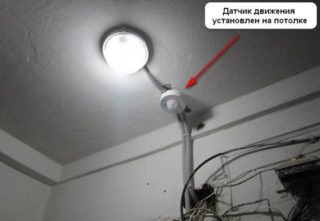Lighting devices are installed in each room. Switching on and off systems are constantly being improved. The range of electrical goods has been expanded with a device called "motion sensor". A small mechanism using infrared radiation reacts to any movement in space along a given search radius. The device is used for different purposes. Installing the device together with a switch will save money and add comfort during normal use. There are several basic methods for connecting a switch and a motion sensor.
- The main functions and principle of operation of the motion sensor
- Specifications
- Additional features
- Installing a motion sensor
- How to connect a motion sensor to a light bulb
- Connection for control without switch
- Connecting to a light bulb with a switch
- Choosing a connection location
- DIY light motion sensor
- Possible problems and solutions
The main functions and principle of operation of the motion sensor

The main task of the microcontroller connected to the switch and the lighting device is to switch the electrical network (close / open). Any movement in the control zone starts the operation of the device. In addition, the device can be configured in such a way that the intensity of illumination is regulated by the intensity of traffic - special controllers are used.
When the value is less than the set limit, the indicator closes the circuit and the lamp lights up. The detector works around the clock. The standard indication threshold is from 3 to 2,000 Lx.
Some appliances can be set for specific operating hours. For example, in an office there is no need to turn on the lights at night. Such indicators are more expensive, but they allow you to save energy.
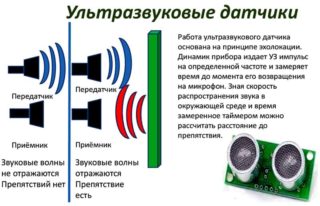
According to the principle of operation, sensors are distinguished:
- infrared - work on the basis of thermal radiation;
- ultrasonic - acts as an echo-finder - sound waves, reflecting from moving objects, change their length, which serves as a signal for switching;
- microwave - similar in type of action to ultrasonic, but more sensitive, they "detect" an object, even if it is not in the line of sight;
- laser - they consist of a receiver and an emitter, the signal is sent between devices, if interrupted by a moving object - the lamp turns on;
- combined (based on the name - combine the functions of several types of devices).
The connection diagram of the motion sensor is quite simple. You can install the device yourself without involving wiring specialists. To exclude errors and unpleasant situations, you should familiarize yourself in advance with the basic methods of inserting the mechanism, the types of devices.
Specifications
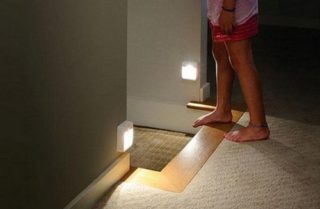
In addition to the type of motion sensor, it is important to take into account its technical parameters: capture angle, range, lamp power, installation method, additional features. For models with wireless connection, consider the range of the supplied beam and the type of battery.
The displacement indicator for switching the electrical network has a certain viewing range relative to the horizon. If the territory can be accessed from different directions, use devices with a radius of 180 to 360 °. For wall-mounted, 180 ° is enough, on a pole - 360 ° is better. For small rooms, indicators with a smaller angle are suitable.The cost of wide-angle devices is much higher, it is better to be guided by the degree of need.
The range of action is selected based on the dimensions of the room. The price is fundamentally different, so it is important to know exactly the length of the room or corridor when buying. At the same time, it is important to leave a small margin (about 0.5 meters), but you should not overdo it - frequent incorrect signals are possible.
Motion sensors are installed in outdoor and home environments. In addition, detectors are distinguished by the installation method:
- cabinet products are fixed on supports, which are fixed on the surface (wall, pillar, ceiling);
- hidden models are almost invisible.
If a detector in a room is needed solely for convenience, the first type is used - with the same data, the cost will be lower. The latter are installed in security systems. The size of such devices is smaller, but the price is much higher.
Additional features
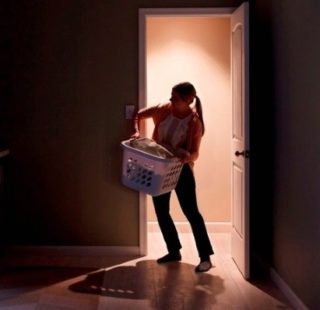
Certain models of indicators are used with greater comfort due to the availability of additional functions. Mechanisms are more expensive, they are selected as needed.
- Indicator of external natural light - the indicator is triggered by movement, but during the day there is no need for additional artificial lighting, so they put a limiter - a separate element of a photo relay or a finished product with a built-in device;
- Animal recognition - this option is suitable if there are small animals in the house or on the street: cats, dogs, chickens, and others. However, animals of large breeds will still be marked and "give" a signal to switch on.
- Timer to turn off the light in the absence of movement after leaving the control zone.
The most useful are DDs with animal recognition and a timer. According to user reviews, devices with built-in options are really easy to use.
Installing a motion sensor
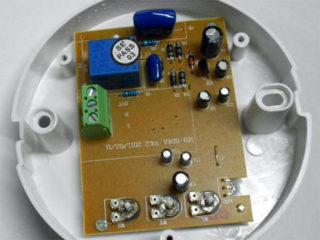
To begin with, determine the method of connecting an additional cable to the switch (external, internal). Before direct connection, remove the outer cover of the case - at the location of the latch, pry the panel with a slotted screwdriver. There are two ways to bring the wire into the device:
- behind - the option is suitable for electrical wiring laid inside the wall;
- on the side - suitable for an external electrical network.
The temporary plug is removed. Start connecting the wires. Microcontacts are separated by letter designations. Usually the symbols L, N and L1 are used - it depends on the manufacturer and the configuration of the indicator.
General installation tips:
- It is not recommended to connect motion sensors with energy saving bulbs. The service life of the latter is significantly reduced with such an addition.
- It is important to exclude trees and bushes from the detector's field of view. They can emit a small amount of heat, which will be enough to activate the indicator;
- The sensor beam should be turned in the direction where the movement begins: to the front door, gate.

It is necessary to adjust the sensor to the required sensitivity level using the service values of the potentiometers. In classic devices, there are three swing arms:
- delay period (Time);
- sensitivity (Meter);
- brightness (Lux).
The shutdown delay shows the time after which the lamp turns off if there is no movement in the room. The brightness level - the intensity of the light when turned on in complete darkness - must be adjusted so as not to dazzle the eyes. First, set to a minimum, during operation - to the desired level of comfort, as well as the sensitivity indicator.
The last step of the installation is testing the work.To do this, use the Test mode of the Time indicator.
All work is carried out with a completely de-energized electrical circuit. Only at the stage of testing the system can the power supply be turned on.
For about a minute after connecting the current, the device will initiate and activate. Checking the operability of the mechanism can be carried out without connecting lighting devices - you can navigate by a small LED on the body.
How to connect a motion sensor to a light bulb
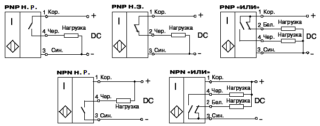
There are several ways to connect a motion sensor. Each depends on the type of lamp used. Instructions for installing the detector into holes for spotlights:
- completely de-energize the room;
- remove the protective panel of the detector;
- connect the conductors according to the diagram on the body;
- bend the fixing springs up;
- install the mechanism into the prepared hole.
The final stages are general - adjusting sensitivity, time, brightness and performance testing.
Detectors that are attached to the cartridge are easier to install. First, the indicator is screwed in, then the light. You cannot take more powerful ones than indicated in the technical passport for the motion sensor. On the market you can find special double lamps specially designed for tandem with detectors. Electricians recommend purchasing just such.
Connection for control without switch
A circuit without a switch is assembled from a motion sensor and a lighting device. It is the simplest and fastest. The description is given in the documentation supplied with the detector and on the body of the device.
For long rooms, one device may not be enough - a small range. The required number of mechanisms are connected in parallel through the microcontacts of the same name, then supplied to the lamp.
Connecting to a light bulb with a switch
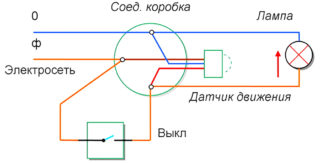
The switch is necessary if it is necessary to turn off the automatic switching system of the electrical circuit. The device is cut in the area between the motion sensor and the power supply. The connection is made through the input and output phase conductors - thus creating a bypass connection.
The switch is convenient to use in a room where you need to maintain lighting, but there is no movement. It is enough to turn off the electricity supply to the sensor and the dump will burn as long as needed.
Choosing a connection location
For the device to work correctly, you must adhere to certain rules:
- the absence of lighting devices in the immediate vicinity, except for devices specially designed for this;
- location next to heating equipment is not allowed: air conditioners, stoves, heat guns, the like.
As the height of the placement increases, the range also increases. But in this case, the sensitivity of the device is lost.
DIY light motion sensor
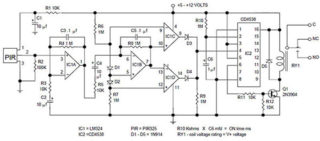
A motion sensor that searches for thermal radiation from moving objects is the simplest and most frequently used device of this type. The advantages of the models are the availability of parts (in terms of price and availability), the absence of complex adjustments, a significant range of temperature limits, and simple assembly.
The factory-made product can be purchased from an electrical outlet. The device is available for assembly at home - just get acquainted with the general principles of working with electricity, circuit and components:
- heat detector;
- photo relay;
- resistors (to set the response limit);
- timer, regulators.
Detector and photo relay - a set for controlling lighting devices. Such a product works only after dark. You can install additional functions as needed.
Possible problems and solutions
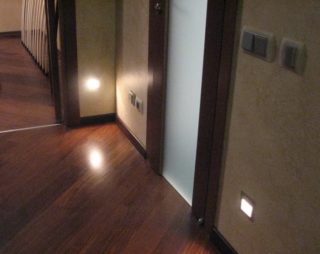
The corridor is the most commonly used place for installing motion detectors in living quarters - this is where the doors of most rooms go. Before installation, a plan of the apartment with wiring is made in order to take into account the area of operation and the type of sensor. If one device is not enough, it is permissible to use a combination of several types of devices.
To independently embed an additional mechanism into the light switching circuit, general knowledge of electronics and safety requirements is sufficient - special skills and equipment are not required. The devices are supplied with the necessary technical information and connection instructions. The main thing is to make the correct connection of the wires and contacts of the device.
A common problem is the insufficient range of operation of one mechanism. To accomplish this task, it is necessary to install several devices at one site. The order of installation of devices is the same - the cables are connected according to the direction of action: phase through the detector, zero for the second wire.
Major mistakes:
- The position of the device in the room space - the manufacturer's technical recommendations must be observed. For example, ceiling products cannot be wall-mounted.
- The presence of shutters - special lens-masks are installed in the device for correct adjustment, after testing they are removed, if this is not done, the detector will not be able to "catch" the movement.
- Incorrect connection to a circuit with a switch - the detector is cut in front of the light switch, otherwise the network will break and the device will become impossible to work.
It is necessary to take into account the recommendations enshrined in the technical documentation for the product, as well as remember the general rules for installing movement indicators.
Connecting an additional detector will simplify some aspects of using the premises and help save money. Each of the advantages can be realized if you comply with the requirements for the selection of devices and the assembly of circuit elements in terms of technical characteristics, selection of location and installation. Otherwise, the devices will not work correctly - false switching on, burnout of bulbs and mains.

